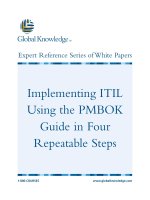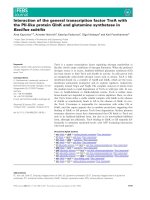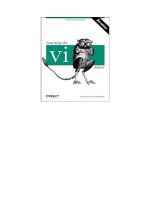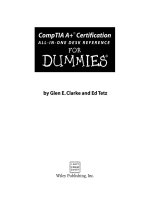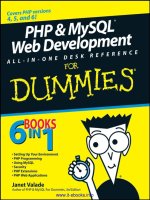CAPM PMP project management certification aligned with the PMBOK guide 6th edition exam guide all in one 4th edition
Bạn đang xem bản rút gọn của tài liệu. Xem và tải ngay bản đầy đủ của tài liệu tại đây (13.96 MB, 689 trang )
ABOUT THE AUTHOR
Joseph Phillips, PMP, PMI-ACP, ITIL, Project+, CTT+, is the Director of Education for
Instructing.com, LLC. He has managed and consulted on projects for industries including technical,
pharmaceutical, manufacturing, and architectural, among others. Joseph has served as a project
management consultant for organizations creating project offices, maturity models, and best-practice
standardization.
As a leader in adult education, Joseph has taught organizations how to successfully implement
project management methodologies, adaptive project management, information technology project
management, risk management, and other courses. He has taught at Columbia College, University of
Chicago, Ball State University, and for corporate clients such as IU Health, the State of Indiana, and
Lawrence Berkeley National Laboratories. A Certified Technical Trainer, Joseph has taught more
than 50,000 professionals and has contributed as an author or editor to more than 35 books on
technology, careers, and project management.
Joseph is a member of the Project Management Institute (PMI) and is active in local project
management chapters. He has spoken on project management, project management certifications, and
project methodologies at numerous trade shows, PMI chapter meetings, and employee conferences in
the United States and in Europe. When not writing, teaching, or consulting, Joseph can be found
behind a camera or on the working end of a fly rod. You can contact him through
www.instructing.com.
About the Technical Editor
Karen Fox’s career in project management has spanned more than 30 years. She has managed IT
projects initially utilizing the traditional waterfall methodology and then utilizing a blending of
waterfall and agile in recent years. She has worked in industries both in the private and New York
City government sectors and has provided project leadership to cross-functional teams including IT
staff, business users, and consultants. Karen acquired her PMP certification in 2004.
Karen has enjoyed a volunteer career spanning more than 15 years with PMI New York City
Chapter (PMINYC). She has held a broad spectrum of positions contributing to the leadership of
PMINYC, including Vice President of Programs (2006–2008), President Elect (2009, 2017),
President (2010), Director of Marketing (2013–2014), and Director of Governance (2016). Presently
serving as President Elect, she will become Chapter President January 2018.
In 2011 she was selected by PMI to join the 2012 Leadership Institute Master Class and served on
the PMI Chapter Awards Review Committee from 2013 to 2014. In 2014, PMINYC presented Karen
with a Lifetime Achievement Award.
Copyright © 2018 by McGraw-Hill Education. All rights reserved. Except as permitted under the
United States Copyright Act of 1976, no part of this publication may be reproduced or distributed in
any form or by any means, or stored in a database or retrieval system, without the prior written
permission of the publisher, with the exception that the program listings may be entered, stored, and
executed in a computer system, but they may not be reproduced for publication.
ISBN: 978-1-25-986159-8
MHID:
1-25-986159-7
The material in this eBook also appears in the print version of this title: ISBN: 978-1-25-986162-8,
MHID: 1-25-986162-7.
eBook conversion by codeMantra
Version 1.0
All trademarks are trademarks of their respective owners. Rather than put a trademark symbol after
every occurrence of a trademarked name, we use names in an editorial fashion only, and to the benefit
of the trademark owner, with no intention of infringement of the trademark. Where such designations
appear in this book, they have been printed with initial caps.
McGraw-Hill Education eBooks are available at special quantity discounts to use as premiums and
sales promotions or for use in corporate training programs. To contact a representative, please visit
the Contact Us page at www.mhprofessional.com.
TERMS OF USE
This is a copyrighted work and McGraw-Hill Education and its licensors reserve all rights in and to
the work. Use of this work is subject to these terms. Except as permitted under the Copyright Act of
1976 and the right to store and retrieve one copy of the work, you may not decompile, disassemble,
reverse engineer, reproduce, modify, create derivative works based upon, transmit, distribute,
disseminate, sell, publish or sublicense the work or any part of it without McGraw-Hill Education’s
prior consent. You may use the work for your own noncommercial and personal use; any other use of
the work is strictly prohibited. Your right to use the work may be terminated if you fail to comply
with these terms.
THE WORK IS PROVIDED “AS IS.” McGRAW-HILL EDUCATION AND ITS LICENSORS
MAKE NO GUARANTEES OR WARRANTIES AS TO THE ACCURACY, ADEQUACY OR
COMPLETENESS OF OR RESULTS TO BE OBTAINED FROM USING THE WORK,
INCLUDING ANY INFORMATION THAT CAN BE ACCESSED THROUGH THE WORK VIA
HYPERLINK OR OTHERWISE, AND EXPRESSLY DISCLAIM ANY WARRANTY, EXPRESS
OR IMPLIED, INCLUDING BUT NOT LIMITED TO IMPLIED WARRANTIES OF
MERCHANTABILITY OR FITNESS FOR A PARTICULAR PURPOSE. McGraw-Hill Education
and its licensors do not warrant or guarantee that the functions contained in the work will meet your
requirements or that its operation will be uninterrupted or error free. Neither McGraw-Hill Education
nor its licensors shall be liable to you or anyone else for any inaccuracy, error or omission,
regardless of cause, in the work or for any damages resulting therefrom. McGraw-Hill Education has
no responsibility for the content of any information accessed through the work. Under no
circumstances shall McGraw-Hill Education and/or its licensors be liable for any indirect,
incidental, special, punitive, consequential or similar damages that result from the use of or inability
to use the work, even if any of them has been advised of the possibility of such damages. This
limitation of liability shall apply to any claim or cause whatsoever whether such claim or cause
arises in contract, tort or otherwise.
In memory of my brother, Steve Phillips:
a great brother, teacher, and friend.
I miss him dearly.
CONTENTS AT A GLANCE
Part I
Project Management Foundation
Chapter 1
Preparing for the Exam
Chapter 2
Managing a Project in Different Environments
Chapter 3
Working as a Project Manager
Part II
Project Management Professional Testing Areas
Chapter 4
Managing Project Integration
Chapter 5
Managing Project Scope
Chapter 6
Managing Project Schedule
Chapter 7
Managing Project Costs
Chapter 8
Managing Project Quality
Chapter 9
Managing Project Resources
Chapter 10
Managing Project Communications
Chapter 11
Managing Project Risks
Chapter 12
Managing Project Procurement
Chapter 13
Managing Project Stakeholders
Chapter 14
Understanding the Code of Ethics and Professional Conduct
Part III
Appendixes
Appendix A Project Management Documents
Appendix B Passing the CAPM and the PMP Exams
Appendix C About the Download
Glossary
Index
CONTENTS
Acknowledgments
Introduction
Part I
Chapter 1
Project Management Foundation
Preparing for the Exam
All About the PMP Exam
All About the CAPM Exam
Money and Your Exam
Passing the Exam
Creating Your Study Strategy
What Your Exam Is Based On
What Is a Project?
Temping a Project
Defining a Project’s Uniqueness
Changing the Organization
Creating Business Value
Progressively Elaborating a Project
Why Do Projects?
Creating Project Management Business Documents
What Is Project Management?
Back to the PMBOK Guide
Being a Project Expert
Using the Project Management Body of Knowledge
Working with Your Application Area
Examining the Project Management Context
Opening Your Portfolio
Working with Programs
Working with Subprojects
Working with Project Management Offices
Considering Projects and Operations
Identifying the Project Life Cycle
Examining a Project Life Cycle
Comparing Project Life Cycles and Product Life Cycles
Working with Project Management Processes
Exploring the Project Management Processes
Examining the Process Group Interactions
Choosing the Appropriate Processes
Working with Process Groups
Gathering Project Management Data and Information
Gathering Work Performance Data
Creating Work Performance Information
Communicating Through Work Performance Reports
Chapter Summary
Key Terms
Questions
Questions and Answers
Chapter 2
Managing a Project in Different Environments
Working with Enterprise Environmental Factors
Working with Internal Enterprise Environmental Factors
Considering External Enterprise Environmental Factors
Leveraging Organizational Process Assets
Adhering to Processes, Policies, and Procedures
Leveraging Organizational Knowledge Repositories
Working Within an Organizational System
Working in a System
Operating Within Governance Framework
Identifying the Organizational Influences
Completing Projects in Different Organizational Structures
Recognizing Organizational Structures
Managing Project Teams
Working with a PMO
Chapter Summary
Key Terms
Case Study
Managing Projects from Start to Completion
Examining the Project Deliverables
Examining the Project Phases
Controlling Project Changes
Questions
Questions and Answers
Chapter 3
Working as a Project Manager
Exploring the Project Manager Role
Leading the Project Team
Communicating Project Information
Negotiating Project Terms and Conditions
Active Problem-Solving
Identifying the Project Manager Influence
Influencing the Project
Influencing the Organization
Considering Social, Economic, and Environmental Project Influences
Considering International Influences
Considering Cultural and Industry Influences
Building Project Management Skills
Enhancing Skills and Competencies
Introducing the PMI Talent Triangle
Managing Politics in Projects
Serving as a Leader and Manager
Learning Leadership Styles
Creating a Leadership Persona
Performing Project Integration
Integrating Processes
Building Your Cognitive-Level Integration
Examining Context-Level Integration
Chapter Summary
Key Terms
Questions
Questions and Answers
Part II
Chapter 4
Project Management Professional Testing Areas
Managing Project Integration
Developing the Project Charter
Preparing to Create the Project Charter
Choosing a Project to Charter
Knowing the Project Management Methodology
Creating the Charter—Finally
Creating the Assumptions Log
Developing the Project Management Plan
Creating the Project Management Plan
Hosting the Project Kickoff Meeting
Directing and Managing the Project Work
Creating the Project Deliverables
Creating an Issue Log
Responding to Project Conditions
Managing Project Knowledge
Preparing to Manage Knowledge
Reviewing Knowledge Management Tools and Techniques
Reviewing the Results of Knowledge Management
Monitoring and Controlling the Project Work
Monitoring the Project
Analyzing Project Data
Creating a Work Performance Report
Managing Integrated Change Control
Reacting to Change
Using the Project Management Information System
Closing the Project or Phase
Documenting the Closing
Creating the Final Project Report
Chapter Summary
Key Terms
Questions
Questions and Answers
Chapter 5
Managing Project Scope
Planning the Project Scope Management
Creating the Project Scope Management Plan
Creating the Requirements Management Plan
Collecting the Project Requirements
Working with Project Stakeholders
Examining the Outputs of Requirement Collection
Defining Project and Product Scopes
Creating the Project Scope Statement
Using Product Analysis
Using Alternatives Generation
Using Stakeholder Analysis
Examining the Project Scope Statement
Creating the Work Breakdown Structure
Using a WBS Template
Decomposing the Deliverables
Creating the WBS Dictionary
Validating the Project Scope
Preparing for Project Inspection
Inspecting the Project Work
Controlling the Project Scope
Using a Change Control System
Planning for Project Scope Changes
Approving a Change
Chapter Summary
Key Terms
Questions
Questions and Answers
Chapter 6
Managing Project Schedule
Planning Schedule Management
Creating the Schedule Management Plan
Examining the Schedule Management Plan
Utilizing an On-Demand Scheduling Approach
Defining the Project Activities
Making the Activity List
Examining the Activity List
Documenting the Activity Attributes
Building the Milestone List
Updating the Work Breakdown Structure
Sequencing the Project Activities
Considering the Inputs to Activity Sequencing
Creating Network Diagrams
Using the Precedence Diagramming Method
Utilizing Network Templates
Determining the Activity Dependencies
Considering Leads and Lags
Estimating Activity Durations
Considering the Activity Duration Estimate Inputs
Using Analogous Estimating
Applying Parametric Estimates
Creating a Three-Point Estimate
Estimating from the Bottom Up
Factoring in Reserve Time
Evaluating the Estimates
Developing the Project Schedule
Applying Mathematical Analysis
Calculating Float in a PND
Encountering Scheduling on the CAPM or PMP Exam
Applying Schedule Compression
Using a Project Simulation
Using Resource-Leveling Heuristics
Using Project Management Software
Relying on a Project Coding Structure
Considering the Outputs of Schedule Development
Reviewing the Schedule Baseline
Examining the Project Schedule
Utilizing the Schedule Management Plan
Updating the Resource Requirements
Controlling the Project Schedule
Managing the Inputs to Schedule Control
Applying Schedule Control
Measuring Project Performance
Examining the Schedule Variance
Creating a Burndown Chart
Updating the Project Schedule
Applying Corrective Action
Chapter Summary
Key Terms
Questions
Questions and Answers
Chapter 7
Managing Project Costs
Planning for Project Cost Management
Preparing the Cost Management Plan
Examining the Project Cost Management Plan
Determining the Project Costs
Estimating the Project Costs
Creating the Cost Estimate
Examining the Cost Estimate
Budgeting the Project
Creating the Project Budget
Examining the Project Budget
Controlling Project Costs
Managing the Project Costs
Controlling Changes to Project Costs
Using Earned Value Management
Learning the Fundamentals
Finding the Project Variances
Finding the Indexes
Predicting the Project’s Future
The Five EVM Formula Rules
Chapter Summary
Key Terms
Questions
Questions and Answers
Chapter 8
Managing Project Quality
Planning for Quality
Using Quality Planning Tools
Creating the Quality Management Plan
Establishing Quality Metrics
Updating the Project Management Plan and Documents
Managing Quality in the Project
Preparing to Manage Quality
Managing Quality Within a Project
Completing a Quality Audit
Designing for X
Implementing Problem-Solving Techniques
Reviewing the Results of Managing Quality
Controlling Quality in a Project
Preparing to Control Quality
Relying on the Seven Basic Quality Tools
Inspecting Results
Creating a Flowchart
Creating a Control Chart
Creating Pareto Diagrams
Creating a Histogram
Creating a Run Chart
Creating a Scatter Diagram
Completing a Statistical Sampling
Revisiting Flowcharting
Applying Trend Analysis
Examining Control Quality Process Results
Chapter Summary
Key Terms
Questions
Questions and Answers
Chapter 9
Managing Project Resources
Planning for Resource Management
Identifying Organizational Approach for Managing Resources
Relying on Enterprise Environmental Factors
Using the Organizational Process Assets
Referencing the Project Management Plan
Charting the Human Resources
Networking Human Resources
Identifying Roles and Responsibilities
Creating a Project Organization Chart
Creating a Team Charter
Estimating the Activity Resources
Using Expert Judgment
Using Bottom-Up Estimating
Relying on Analogous Estimating
Utilizing Parametric Estimating
Identifying Alternatives
Relying on Published Estimating Data
Examining the Activity Resource Estimates
Acquiring the Project Team
Examining the Staffing Pool
Negotiating for Resources
Working with Preassigned Staff
Procuring Staff
Managing a Virtual Team
Utilizing a Multicriteria Decision Analysis Process
Assembling the Project Team
Developing the Project Team
Preparing for Team Development
Relying on Interpersonal Management Skills
Creating Team-Building Activities
Establishing Project Ground Rules
Rewarding the Project Team
Assessing the Project Team
Managing the Project Team
Preparing for Team Management
Dealing with Team Disagreements
Creating an Issue Log
Examining the Outputs of Team Management
Relating to Organizational Theories
Maslow’s Hierarchy of Needs
Herzberg’s Theory of Motivation
McGregor’s Theory of X and Y
Ouchi’s Theory Z
Vroom’s Expectancy Theory
McClelland’s Theory of Needs
Controlling Resources
Preparing to Control Resources
Reviewing the Tools and Techniques to Control Resources
Reviewing the Results of Controlling Resources
Chapter Summary
Key Terms
Questions
Questions and Answers
Chapter 10 Managing Project Communications
Examining the Communications Foundation
Communication Factors
Understanding the Communications Model
Planning for Communications
Preparing for Communications
Identifying Communication Requirements
Exploring Communication Technologies
Creating the Communications Management Plan
Managing Project Communications
Examining Communication Skills
Examining Communication Factors and Technologies
Distributing Information
Creating Lessons Learned
Examining the Results of Communications Management
Monitoring Communications
Examining the Tools for Monitoring Communications
Reviewing Project Performance
Analyzing Project Variances
Examining the Results of Monitoring Communications
Chapter Summary
Key Terms
Questions
Questions and Answers
Chapter 11 Managing Project Risks
Planning for Risk Management
Preparing for Risk Management Planning
Completing Risk Management Planning
Creating the Risk Management Plan
Identifying the Project Risks
Finding Project Risks
Creating a Risk Register
Creating a Risk Report
Using Qualitative Risk Analysis
Preparing for Qualitative Analysis
Completing Qualitative Analysis
Applying Probability and Impact
Creating a Probability-Impact Matrix
Relying on Data Precision
Building a Hierarchical Chart
Assessing the Risk Score
Examining the Results of Qualitative Risk Analysis
Preparing for Quantitative Risk Analysis
Interviewing Stakeholders and Experts
Applying Sensitivity Analysis
Finding the Expected Monetary Value
Using a Decision Tree
Using a Project Simulation
Examining the Results of Quantitative Risk Analysis
Planning for Risk Responses
Preparing for Risk Responses
Creating Risk Responses
Managing the Positive Risk and Opportunities
Accepting the Risks
Updating the Risk Register
Creating Contracts for Risk Response
Justifying Risk Reduction
Creating a Project Contingency Response
Updating the Project Plan
Implementing Risk Responses
Preparing to Implement Risk Responses
Reviewing the Tools and Techniques for Implementing Risk Responses
Examining the Results of Implementing Risk Responses
Monitoring Project Risks
Preparing for Risk Monitoring and Control
Monitoring and Controlling Risks
Completing Risk Response Audits
Analyzing Project Variances
Measuring Technical Performance
Monitoring Contingency Reserve
Examining the Results of Risk Monitoring and Control
Chapter Summary
Key Terms
Questions
Questions and Answers
Chapter 12 Managing Project Procurement
Planning for Procurement
Determining the Contract Type
Understanding Contract Types
Using the Procurement Planning Tools
Examining the Results of Procurement Planning
Creating the Procurement Documents
Creating Source Selection Criteria
Conducting Procurements
Hosting a Bidder Conference
Advertising for Sellers
Creating a Qualified Sellers List
Selecting a Seller
Examining Vendor Responses
Choosing the Seller
Examining the Results of Seller Selection
Controlling Project Procurements
Completing the Procurement Control Process
Reviewing the Results of Procurement Control
Performing Contract Closure
Auditing the Procurement Process
Negotiating Settlements
Completing Contract Closure
Chapter Summary
Key Terms
Case Study: Litke Greenhouse and Nursery Procurement Processes
Planning for Procurement
Hosting a Bidder Conference
Selecting a Vendor
Questions
Questions and Answers
Chapter 13 Managing Project Stakeholders
Identifying Project Stakeholders
Preparing for Stakeholder Identification
Launching Project Stakeholder Identification
Performing Stakeholder Analysis
Classifying Stakeholders
Finalizing Stakeholder Identification
Creating the Stakeholder Register
Planning Stakeholder Management
Preparing to Plan for Stakeholder Management
Creating the Stakeholder Engagement Plan
Examining the Stakeholder Engagement Plan
Managing Stakeholder Engagement
Preparing to Manage Stakeholder Engagement
Managing Stakeholder Relationships
Reviewing Stakeholder Engagement Results
Monitoring Stakeholder Engagement
Preparing to Monitor Stakeholder Engagement
Components of Monitoring Stakeholder Engagement
Reviewing the Outputs of Stakeholder Engagement
Chapter Summary
Key Terms
Questions
Questions and Answers
Chapter 14 Understanding the Code of Ethics and Professional Conduct
Learning the Code of Ethics
Exploring the Code’s Vision and Purpose
Participating in the Code
Learning the Code Details
Serving Responsibly as a Project Manager
Defining Responsibility
Aspiring to Responsibility Expectations
Adhering to the Mandatory Standards of Responsibility
Adhering to the Respect Value
Aspiring to Respect
Adhering to the Mandatory Values of Respect
Being a Fair Project Manager
Aspiring to Fairness
Adhering to the Mandatory Standards on Fairness
Being an Honest Project Manager
Aspiring to Honesty
Living the Honesty Requirements
Chapter Summary
Key Terms
Questions
Questions and Answers
Part III
Appendixes
Appendix A Project Management Documents
Appendix B Passing the CAPM and the PMP Exams
Tips to Pass the Exam
Prepare Before the Exam
Create Your Own Answer Key
Testing Tips
Answer Every Question—Once
Use the Process of Elimination
Everything You Must Know
The 49 Project Management Processes
Earned Value Management Formulas
Quick Project Management Facts
A Letter to You
Appendix C About the Download
System Requirements
Installing and Running Total Tester
Total Tester Premium Practice Exam Software
McGraw-Hill Professional Media Center Download
Video Training from the Author
Technical Support
Total Seminars Technical Support
McGraw-Hill Education Content Support
Glossary
Index
ACKNOWLEDGMENTS
More than once, I’ve said that I’m the luckiest guy in the room. I get to write and talk for a living—
what could be better than that? I’m so grateful for the opportunity to write, and I must thank the
wonderful group of people at McGraw-Hill Education for their belief in me to write yet another book
on project management. Thank you to Wendy Rinaldi for all of your help, great conversations, and
guidance on this book and others. Thank you, Claire Yee, for your management and organization of
this book—you are fantastic. Thank you to Jody McKenzie for your keen eye, attention to detail, and
for all your hours and help. Lisa Theobald, thank you for helping me be a better writer. Thank you to
Production Supervisor Jim Kussow for your work on this book. Thanks also to the production teams
at McGraw-Hill Education and Cenveo Publisher Services for your hard work in making this book a
success.
I would also like to thank the hundreds of folks who have attended my PMP Boot Camps over the
past couple of years. Your questions, conversations, and recommendations have helped me write a
better book. Thank you to my lovely wife and best friend, Natalie. A big thank you to my friends Greg
and Mary Huebner, Jonathan Acosta, Brett and Julie Barnett, Don “Just Publish It Already” Kuhnle,
Greg Kirkland, Beatrice Best, my Sarasota pals, Monica Morgan, and all my clients. Thank you also
to my friends and in-laws, Bernie and Alice Morgan. Finally, thanks to my parents, Don and Virginia
Phillips, and my brothers, Steve, Mark, Sam, and Ben.
INTRODUCTION
This book is divided into two major sections. Part I, which consists of Chapters 1, 2, and 3, discusses
the broad overview of project management and how it pertains to the Certified Associate in Project
Management (CAPM) and the Project Management Professional (PMP) examinations. Part II contains
Chapters 4 through 14, which detail each of the ten knowledge areas and the PMI Code of Ethics and
Professional Conduct.
If you are just beginning your PMP or CAPM quest, you should read the first section immediately,
as it will help you build a strong foundation for your exam. If you already have a strong foundation in
project management and need specific information on the knowledge areas, then move on to the
second section. You’ll find this section specific to the exam knowledge areas that will help you—
gulp—pass the PMI examination.
The book is designed so that you can read the chapters in any order you like. However, if you
examine A Guide to the Project Management Body of Knowledge (PMBOK Guide), you’ll notice
that the order of information presented there is the same as the order of information in this book. In
other words, you can read a chapter of the PMBOK Guide and then read a more detailed explanation
in this book. This book is a guide to the guide.
PMP Exam Objectives Map
CAPM Exam Objectives Map
PART I
Project Management Foundation
Chapter 1
Chapter 2
Chapter 3
Preparing for the Exam
Managing a Project in a Different Environment
Working as a Project Manager
